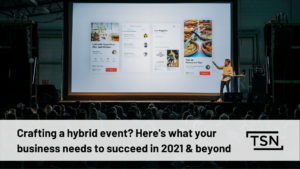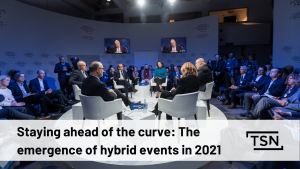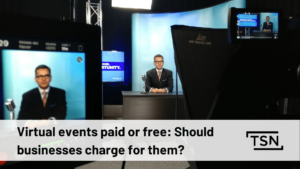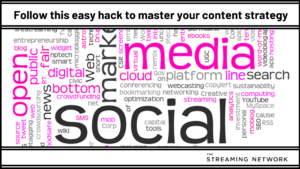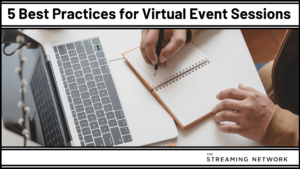We previously discussed the value of ABM webinars to both sales and marketing departments alike (along with ABM webinar tips).
When either department is running a webinar of any kind, engagement is a critical KPI to measure success against.
Imagine you have hosted your first few webinars, but you have no idea how to make webinars more engaging. You don’t even know if people were truly paying attention.
You know your chosen webinar software offers engagement tools like surveys and polling, but you don’t know where/how/when to use them; or even why.
Webinar engagement is a common problem for both sales and marketing. Considering how large an investment it is to host a webinar, you want to make sure you are yielding positive results.
Learn what webinar engagement can mean to your webinar strategy, and webinar tips to improve it.
Engagement Means They Are Learning
Everyone is different, and everyone learns differently.
You will have some viewers that can listen to you present your webinar and immediately understand what you are telling them. Other more visual learners may need to read your well-designed slides on screen to fully understand your message.
Those that are more logic driven may need to interact with a quiz, poll, or discussion question throughout your webinar to help galvanize their learning.
Engagement is a great measurement tool. It helps you understand if your webinar attendees are really taking away valuable concepts from your content.
Adding a mix of Q&A’s, group discussions, brainstorming sessions and other engagement features to your webinar will ensure that, no matter their learning style, every one of your attendees will understand what you are telling them. This is a common technique used in continuing education webinars.
Learning is critical for people hosting webinars directed to sales prospects and leads.
Be mindful that your webinar attendees may not be the final decision maker. They may be your champion though. If they are to go to their supervisor or manager and make the case to use your service, it would be wise to arm them with the most accurate data and information.
Well-educated prospects that are knowledgeable of your service will end up becoming your champion MQLs, and are more likely to convert to SQLs.
Engagement Means They Are Qualified
Remember, not all leads are made the same.
Your job as a sales or marketing representative is to
- Determine how qualified a lead is.
- Provide them the information they need to make a decision (at the right times).
- Drive them to make a purchase.
If you were simply to consider everyone who viewed your webinar as a “hot” lead, you would waste valuable resources chasing unqualified leads. Or even worse, you might scare them off trying to go straight to booking a meeting when they are still early in their research.
Using engagement features throughout your webinar can help you determine which viewers are giving you their full attention, and which ones are asleep at the keyboard. To measure your lead’s engagement, try some of the following on your next webinar:
- Take a poll asking the viewers how confident they are with your topic before and after your webinar.
- Pair up strangers using webinar brainstorming functionality and task them with solving a problem.
- Add a twitter feed, encouraging viewers to tweet during the webinar to have their say.
- See how long the average viewer spends on your webinar (they should pass the 50% mark at the very least).
With the ability to score your leads based on these more nuanced engagement metrics, you save vital marketing and sales resources and ensure no hot lead is missed.
Engagement Means You Have Chosen The Right Topic
You can have the best quality recordings & the most engaging features, but if you do not pick the right topic, it is all for naught.
The best webinar topics are those that answer a viewer’s pressing questions to save them from doing their own research. A webinar trick is to ask yourself the following questions when choosing a topic:
- What’s on my target audience’s plate this upcoming quarter?
- Which technologies recently changed their role that they might need to learn more about?
- What topic do you or your close network know well enough to present expertly?
- What buzz terms are flying around the target audiences that could use a more thorough explaining?
If you are at a loss for ideas, try reading your target audience’s preferred industry websites, or look through their twitter accounts. The more timely or relevant a topic, the more engaging your audience will find it.
Need more assistance? Download our Topic Mapping Template to help narrow down on relevant webinar topics.
Let’s Recap
Let’s do a quick summary of what engagement means to your webinar strategy:
- Engagement means your audience is learning. Ensure that the lesson sticks by working in a variety of polls, presentation slides, and other webinar engagement features into your program.
- Engagement means your leads are qualified. Score the leads that tune into your webinar by their level of engagement to better qualify leads for your sales team to follow up with.
- Engagement means you have chosen the right topic. Research what your audience is talking about online and what challenges they are facing to choose increasingly better webinar topics.
A Bonus in Your Webinar Tool Kit
Engagement is only one part of the picture.
If you are regularly hosting marketing or sales webinars, the webinar ROI eBook is for you (and for free). Learn how to save time and resources running your webinars, while still getting record results.


